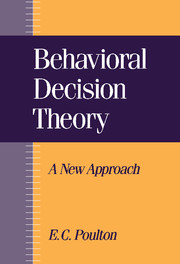Book contents
- Frontmatter
- Acknowledgments
- Contents
- Preface
- Chapter 1 Outline of heuristics and biases
- Chapter 2 Practical techniques
- Chapter 3 Apparent overconfidence
- Chapter 4 Hindsight bias
- Chapter 5 Small sample fallacy
- Chapter 6 Conjunction fallacy
- Chapter 7 Regression fallacy
- Chapter 8 Base rate neglect
- Chapter 9 Availability and simulation fallacies
- Chapter 10 Anchoring and adjustment biases
- Chapter 11 Expected utility fallacy
- Chapter 12 Bias by frames
- Chapter 13 Simple biases accompanying complex biases
- Chapter 14 Problem questions
- Chapter 15 Training
- Chapter 16 Overview
- References
- Index
Chapter 9 - Availability and simulation fallacies
Published online by Cambridge University Press: 06 July 2010
- Frontmatter
- Acknowledgments
- Contents
- Preface
- Chapter 1 Outline of heuristics and biases
- Chapter 2 Practical techniques
- Chapter 3 Apparent overconfidence
- Chapter 4 Hindsight bias
- Chapter 5 Small sample fallacy
- Chapter 6 Conjunction fallacy
- Chapter 7 Regression fallacy
- Chapter 8 Base rate neglect
- Chapter 9 Availability and simulation fallacies
- Chapter 10 Anchoring and adjustment biases
- Chapter 11 Expected utility fallacy
- Chapter 12 Bias by frames
- Chapter 13 Simple biases accompanying complex biases
- Chapter 14 Problem questions
- Chapter 15 Training
- Chapter 16 Overview
- References
- Index
Summary
Summary
The availability and simulation heuristics are used when people do not know the frequency or probability of instances in the outside world, and so cannot follow the normative rule of using objective measures. Instead they judge frequency or probability by assembling the stored information that is available in memory. This can lead to the availability fallacy when what is retrieved from memory is biased by familiarity, by the effectiveness with which memory can be searched, by misleading unrepresentative information, or by imaginability.
The simulation fallacy is the name given to an erroneous estimate of frequency or probability that is obtained by the heuristic of imagining or constructing instances, instead of by recalling instances. The availability fallacy may be responsible for some of the commonly reported associations between the Draw a Person test and the symptoms reported by patients.
Judged frequency or probability depends on subjective availability or ease of simulation
Tversky and Kahneman (1973, pp. 208–9) distinguish between availability in the outside world, which can be called objective availability, and availability in a person's stored experience or memory, which can be called subjective availability. Subjective availability is based on the frequency or strength in memory of associative bonds. The normative rule is to use objective measures of availability in the outside world. But when objective measures are not available, people have to adopt Tversky and Kahneman's availability heuristic of judging frequency or probability in the outside world using subjective availability.
- Type
- Chapter
- Information
- Behavioral Decision TheoryA New Approach, pp. 162 - 186Publisher: Cambridge University PressPrint publication year: 1994



